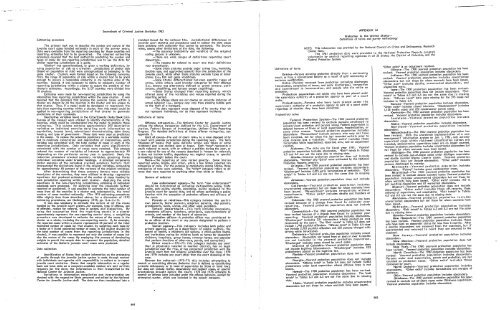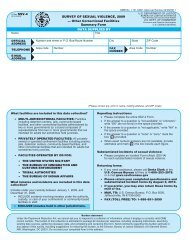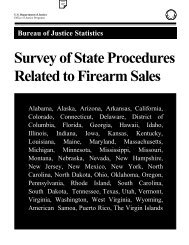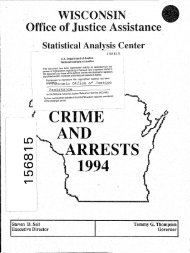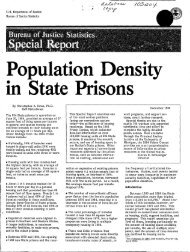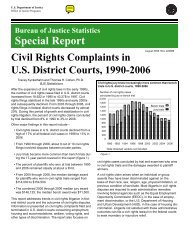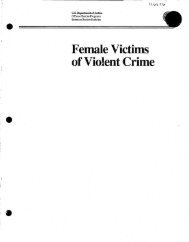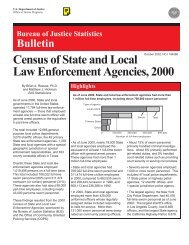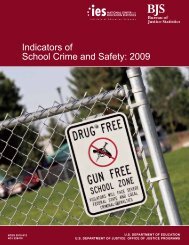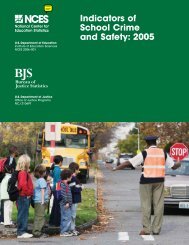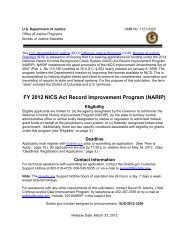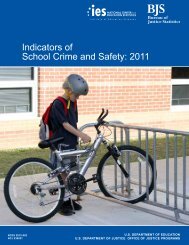,-flC!urcebook <strong>of</strong> <strong>Criminal</strong> <strong>Justice</strong> <strong>Statistics</strong> <strong>1983</strong>inhalants. Data for locker room odorizers are included within generaldata on inhalants and are also pra,ided separately. 1977 and 1976:glue or some other substances that people inhale for kicks or to gethigh. Besides glue, there are things like gasoline, some aerosols,nitrous oxide, amyl nitrate that is also called "poppers" and othersolvents. 1974: glu!': or some other inhalant. 1972: glue or otherthings YOll breathe in.Marihuana-1982 and 1979: marihuana and/or hashish. 1977,1976, 1974, 1972, and 1971: marihuana only.Nonmedical experience with psychotherapeutic drugs-1982:Use <strong>of</strong> a pill or other drug(s) from any <strong>of</strong> the four psychotherapeuticdrug categories in order to get high or to enjoy the feeling or just forkicks or curiosity or for any other nonmedical purpose. 1979, 1977,1976, and 1974: a "yes" or "not sure" response to anyone (or more) <strong>of</strong>the following three items: Did you ever take any <strong>of</strong> these kinds <strong>of</strong> pillsjust to see what it was like and how it would work? Did you evertake any <strong>of</strong> these kinds <strong>of</strong> pills just to enjoy the feeling they give you?Did you ever take any <strong>of</strong> these pills for some other nonmedical reason,and not because you needed it? Note: the responses to the 1982nonmedical experience with psychotherapeutic drugs questions weremarked on a private answer sheet rather than being spoken to theinterviewer as in 1979, 1977, 1976, 1974, and 1972. Note: in 1977only, questions about nonmedical experience were assigned to a randomhalf <strong>of</strong> the households in which interviews were conducted. 1972: a"yes" resp'.:mse to anyone (or more) <strong>of</strong> the following five items: Hoveyou ever taken these pills to help you get along with your family orother people? Hove you ever taken any <strong>of</strong> these pills to help you getready for some big event, or help you accomplish something? Did youever take any <strong>of</strong> these kinds <strong>of</strong> pills just to see what it was like andhow it would work? Hove you ever taken any <strong>of</strong> these pills beforegoing out, so that you could enjoy yourself more with other people?Did you ever take these kinds <strong>of</strong> pills just to enjoy the feeling theygive you?Now a full-time college student-1982, 1979, 1977, and 1976:This term is defined by a "yes" response to the question: "Are you astudent or taking any course this year in a college or other kind <strong>of</strong>school?"; a "college" or "community college" response to the question:"Is that a college or a vocational school, or what?"; and a "full-time"response to the question: "Are you a full-time student or a part-timestudent?"Population densityLarge metropolitan areas-includes the StandardMetropolitan Statistical Areas (SMSA's) with populations <strong>of</strong>1,000,000 or more in 1970. Large metropolitan areas includecentral cities and surrounding areas as defined by the U.S. <strong>Bureau</strong><strong>of</strong> the Census.Small metropolitan areas-includes a sample <strong>of</strong> thoseStandard Metropolitan Statistical Areas under 1,000,000 inpopulation in 1970.Nonmetropolitan area-includes a sample <strong>of</strong> those areasthat were not part <strong>of</strong> a Standard Metropolitan Statistical Area as<strong>of</strong> 1970, according to standards set by' the U.S. <strong>Bureau</strong> <strong>of</strong> theCensus. In general, this includes smaller communities, rural nonfarmareas, and rural farm areas.Race-Race is grouped info two categories, "White" and"Nonwhite". Note: due to recent changes in Federal reporting optionsfor race and ethnicity as well as frequent changes in the administrationand content <strong>of</strong> such items over time, Hispanics have appeared in bathracial categories. In 1982 and 1979, Hispanics Were included in the"White" category; in 1977, they appeared in one or the other categorydepending on how they identified themselves; in 1976 and 1974 theywere included in one or the other category depending on how theinterviewer identified them; and in 1972 and 1971, all Hispanicsappeared in the ''Nonwhite'' category.White-1982: those individuals who chose the category Wnite orHispanic as the category that best described them. 1979: thoseindividuals who state that their fomily origin Is White or that they are<strong>of</strong> Spanish-American origin. 1977: those individuals who state thattheir family origin is White. 1976, 1974, 1972, and 1971: thoseindividuals whose racial background, according to interviewerobservation, is determined to be White.Nonwhite-1982: those individuals who stated that they wereBlack, American Indian or Alaskan Notive, Asian or Pacific Islander, orwho volunteered Black/Hispanic or some other combination. 1979 and1977: those individuals who state that their fomily origin is AmericanIndian, Alaskan Native, Asian, Black, Pacific Islander, or some otherrace (other than White). 1976 and 1974: those individuals whose racialbackground, according to interviewer observation, is determined to beAmerican Indian, Black, Oriental, or some other race (other thanWhite). 1972 and 1971: those individuals whose category, according tointerviewer observation, is determined to bp. Black, Puel to Rican orother Latin American group, or some other category (other thanWhite).RegionNortheast-Connecticut, Maine, Massachusetts, NewHompshire, New Jersey, New York, Pennsylvania, Rhode Island,VermontNorth Central-Illinois, Indiana, Iowa, Kansas, Michigan,Minnesota, Missouri, Nebraska, North Dakota, Ohio, South Dakota,WisconsinSouth-Alabama, Arkansas, Delaware, District <strong>of</strong> Columbia,Florida, Georgia, Kentucky, LOUisiana, Maryland, Mississippi, NorthCarolina, Oklahoma, South Carolina, Tennessee, Texas, Virginia,West VirginiaWest-Arizona, California, Colorado, Idaho, Montana,Nevada, New Mexico, Oregon, Utah, Washington, WyomingSedatives-1982 and 1979: barbiturates and other sedatives usedmedically to help people relax or sleep. Sedatives are divided Into foursubgroups: intermediate/long acting barbiturates, nonbarbiturate/nonbenzodiazepinesedatives, short acting barbiturates, and Dalmane.Note: See definition for "nonmedical experience with psychotherapeuticdrugs."Stimulants-1982 and 1979: amphetamines and other stimulantssometimes used medically for weight control. Stimulants are dividedinto four subgroups: amphetamines, nonamphetamine anorectics, Ritalin,and Cylert. Note: See definition for "nonmedical experience withpsychotherapeutic drugs."Tranquilizers-1979: pills used medically to relax nerves andmuscles. Tranquilizers are divided into four subgroups:benzodiazepines, Meprobamate, hydroxyzine, and Benadryl. Note: Seedefinition for "nonmedical experience with psychotherapeutic drugs."Sampling dataAPPENDIX 15Delinquency 1975, 1976, 1977, 1978, 1979, 1980-Survey methodology and definitions <strong>of</strong> termsf\OTE: The following information has been excerpted from Daniel D. Smith, Terrence Finnegan,Howard Snyder, and Jacqueline Corbett, Delinquency 1975: United States Estimates <strong>of</strong> CasesProcessed by Courts with Juvenile Jurisdiction (Pittsburgh: National Center for Juvenile<strong>Justice</strong>, 1979), pp. 11-4-11-21; Daniel D. Smith, Terrence Finnegan, and Howard N. Snyder,Delinquency 1976: United States Estimates <strong>of</strong> Cases Processed by Courts with JuvenileJurisdiction (Pittsburgh: Notional Center for Juvenile <strong>Justice</strong>, 1979), pp. 17-3!l; Daniel D. Smith,Terrence Finnegan, and Howard N. Snyder, Delinquency 1977: United States, Estimates <strong>of</strong>Cases Processed by Courts with Juvenile Jurisdiction (Pittsburgh: Notional Center forJuvenile <strong>Justice</strong>, 1980), pp. 18-37; Daniel D. Smith, Terrence Finnegan, Howard N. Snyder, NormaG. Feinberg, and Patricia McFall, Delinquency 1978: United States Estimates <strong>of</strong> Ca~esProcessed by Courts with Juvenile Jurisdiction (Pittsburgh: National Center for Juvenile<strong>Justice</strong>, 1981), pp. 5-19, 153-157; Howard Snyder, Terrence Finnegan, Daniel Smith, NormaFeinberg, John Hutzler, and Patricia McFall, Delinquency 1979 (Pittsburgh: National Center forJuvenile <strong>Justice</strong>, 1982), pp.II-28; Howard N. Snyder, Terrence A. Finnegan, and John L. Hutzl.er,Delinquency 1980: A Description <strong>of</strong> Cases Proceesed by United S'ates '-:ourts WithJuvenile Jurisdiction (Pittsburgh: Notional Center for Juvenile <strong>Justice</strong>, 19!:!3), pp. 30-43. Nonsubstantiveeditorial adaptations have been made.the data used to derive the national estimates for 1975-80re;->resen t subsamples drawn from a larger data base. The total database and the subsample for each year are as follows:1975--The total data base consists <strong>of</strong> over 580,000 casesreported from 13 States. The total population <strong>of</strong> these 13 Statesrepresented 42 percent <strong>of</strong> the en1'ire U.S. population and 41 percent <strong>of</strong>the total youth population at risk (from age 10 to the upper age <strong>of</strong>juvenile court jurisdiction).The subsample was generated from 10 States. They include:Connecticut, Marylond, Pennsylvania, and West Virginia in the East;Alabama and Mississippi in the South; Ohio, Kansas, and Nebraska in theMidwest· and California in the West. New York, Florida, and Idahodata we;e excluded because <strong>of</strong> inconsistencies In the methods <strong>of</strong>reporting. The sample <strong>of</strong> these 10 States comprises a total <strong>of</strong> 555counties out a <strong>of</strong> a possible 3, I 4 I nationwide. The sample represents27 percent <strong>of</strong> the total child population within the courts with juvenilejurisdiction. A total number <strong>of</strong> 372,592 cases comprises the sampleused to generate 1975 national estimates.1976--The total data base contains more than 707,000 caserecords collet!ted from 17 States and the District <strong>of</strong> Columbia. After areview, data from New York, Idaho, South Dakota, and the District <strong>of</strong>Columbia were excluded from the estimating sample because <strong>of</strong> internalvariances in reporting methods. The resulting sample includes datafrom Connecticut, Maryland, Pennsylvania, and West Virginia in theEast; Alabama, Florida, and Mississippi in the South; Iowa, Kansas,Nebraska, North Dakota, and Ohio in the Midwest; and California andUtah in the West. The sample used to generate 1976 national estimatesincludes data from 849 <strong>of</strong> the Notion's 3,141 counties and represents35.2 percent <strong>of</strong> the total child population wahin jurisdiction <strong>of</strong> juvenilecourts in the United States.1977--The total data base contains more than 700,000 caserecord$ collected from 17 States and the District <strong>of</strong> Columbia. After areview, data from New York, South Dakota, and the District <strong>of</strong>Columbia were excluded from the estimating sample because <strong>of</strong>significant differences in reporting methods. The resul ling sampleincludes data from Connecticut, Maryland, Pennsylvania, and WestVirginia in the East; Alabama, Florida, and Mississippi in the South;Iowa, Kansas, Nebraska, North Dakota, and Ohio in the Midwest; andCalifornia and Utah in the West. The sample used to generate 1977national estimates Includes data from 856 <strong>of</strong> the Notion's 3,14 I countiesand represents 35.5 percent <strong>of</strong> the total child population withinjurisdiction <strong>of</strong> juvenile courts in the United States.1978--The primary data base consists <strong>of</strong> more than 515,000 caserecords from courts with juvenile jUrisdiction in 13 States (California,Connecticut, Florida, Iowa, Kansas, Maryland, Missi~sippi, NorthDakota, Nebraska, Ohio, Pennsylvania, Utah, and West Virginia), theDistrict <strong>of</strong> Columbia and Clark County, Nevada. Data from 794 <strong>of</strong> the3, I 43 counties in the United States, containing mare than one-third <strong>of</strong>the total child population within the jurisdiction <strong>of</strong> juvenile courts <strong>of</strong>the United States, are represented.1979--The primary data base consists <strong>of</strong> more than 470,000 caserecords from courts with juvenile jurisdiction in 15 States (Alabama,California, Connecticut, Florida, Hawaii, Iowa, Kansas, Maryland,Minnesota, Nebraska, North Dakota, Pennsylvania, South Dakota, Utah,and West Virginia); Maricopa County, Arizona; Clark County, Nevada;and Shelby County, Tennessee. Data from 830 <strong>of</strong> the 3, I 43 counties inthe United States, containing mare than one-third <strong>of</strong> the total childpopulation within the jurisdiction <strong>of</strong> juvenile courts <strong>of</strong> the UnitedStates, are represented.1980--The primary data base consists <strong>of</strong> more than 435,000 caserecords from courts with juvenile jurisdiction in 13 States (Alabama,Californfo, Connecticut, Florida, Hawaii, Iowa, Kansas, Maryland,Nebraska, North Dakota, Pennsylvania, South Dakota, and WestVirginia); Maricopa County, Arizona; and Shelby County, Tennessee.Data from 741 <strong>of</strong> the 3,137 count!e:l in the United States, containingmore than one-quarter <strong>of</strong> the total cilHd population within theJurisdiction <strong>of</strong> juvenile courts <strong>of</strong> the United States, are represented.Child popuiation at riskDeveloping national estimates for 1980 required that the childpapulation at risk be determined for each <strong>of</strong> the 3, i 37 counties in theUo1ited States. "Child population at risk" is defined as the number <strong>of</strong>chi Idren from the age <strong>of</strong> 10 through the lJ,:;per age <strong>of</strong> juvenile courtjurisdiction. Although there may be exclusions based on instant<strong>of</strong>fense, or a combination <strong>of</strong> instant <strong>of</strong>fense and prior delinquencyhistory, the age at which an individual is no longer considered underjuvenile court jurisdiction is defined by State statute. In 191J0, in 37States and in the District <strong>of</strong> Columbia, individuals 18 years <strong>of</strong> oge orolder were within the jurisdiction <strong>of</strong> the criminal courts. In eightStates (Georgia, Illinois, Louisiana, Massachusetts, Michigan, Missouri,South Carolina, and Texas) individuals had to be at least 17 years <strong>of</strong>age to be within the jurisdiction <strong>of</strong> the criminal court, in four States(Connecticut, New York, North Carolina, and Vermont) the individualhad to be at least 16 years <strong>of</strong> age, and in Wyoming individuals had tobe at least 19 years <strong>of</strong> age to be routinely processed as an adult(Source, p. 3 I).Though both public and private sources were checked extensively,no ,ource <strong>of</strong> popUlation estimates by county and age was available forI ~75-79. However, the 197U census data contained information in thisform, and this Information was utilized. In addition, the U.S. <strong>Bureau</strong> <strong>of</strong>the Census, under special contract from the Notional Cancer Institute,had produced population estimates for each year, 1975 through 1979, bycounty in five-~ear age groupings (0 to 4, 5 to 9, etc.).Using the following method, estimates <strong>of</strong> child population at riskwere made for each year from 1975 through 1979. From the 197Ucensus, a summation <strong>of</strong> the number <strong>of</strong> children in a county from 0through 4 years <strong>of</strong> age was made to obtain a total estimate <strong>of</strong> thechildren in this age range. SimilarlY, the process was repeated for the5 through 9 a;ld the 10 through 14 age groups. A percentage <strong>of</strong> thetotal for a particular age was calCUlated by dividing the number <strong>of</strong>children <strong>of</strong> a single age by the total number <strong>of</strong> children in its five-yeargroup. Thus, the relative percentages were d'atermined for 5-, 6-, 7-,8-, and 9-year-olds in 1970; and from the 1975 census estimates, thetotal number <strong>of</strong> youth was determined in the 10 through 14 age groupin 1975 (from the National Cancer Institute data). It was assumedthat the relative percentage <strong>of</strong> 5-year-olds in the 5-to-9 group in 1970would be equivalent to the relative percentage <strong>of</strong> JO-year-olds in 1975.Continuing with this procedure, 1975 estimates <strong>of</strong> the number <strong>of</strong>children <strong>of</strong> each age group from 10 through 19 were developed for eachcounty.Another assumption was that the change in single age populationsfrom 1975 to 1979 would be minimal. For example, the estimate <strong>of</strong> 9-year-olds in 1975 was used as the estimate <strong>of</strong> 13-year-olds in 1979.Knowing the upper age <strong>of</strong> jurisdiction in each county, as estimate wascalculated for the number <strong>of</strong> children from 10 through the upper age <strong>of</strong>jurisdiction (the child population at risk) for each <strong>of</strong> the 3, I 43counties. AJth~..:!)h migration, undercounting, and death rates wouldaffect the extrapalaj Ion af population estimates from one year toanother, It was aS~Jmed that these factors would be <strong>of</strong> minimalimportance for the target group ,nd that they would be <strong>of</strong> minorImportance compared with the impact <strong>of</strong> birth rates and childpopulations. In 1980 the child population at risk was derived form the1980 decennial census counts provided by the U.S. <strong>Bureau</strong> <strong>of</strong> theCensus, unlike the previous ye(jr~ in which the child population at riskfigures were based on estimates developed by the U.S. <strong>Bureau</strong> <strong>of</strong> theCensus.
--~- ~-..---Estimating procedure<strong>Sourcebook</strong> <strong>of</strong> <strong>Criminal</strong> <strong>Justice</strong> <strong>Statistics</strong> <strong>1983</strong>The primary task was to describe the number and nature <strong>of</strong> thejuvenile court cases handled notionally in each <strong>of</strong> the survey years.Data were available from the reporting counties; for those counties notreporting, e$timates hod to be generated. The adopted estimatingprocedure assumed that the best method for predicting the number andtypes <strong>of</strong> cases for non-reporting jurisdictions was to use the data forsimilar reporting jurisdictions as a guide."Similar" was operationalized, or given a working definition, byusing population at risk as a criterion. Jurisdictions <strong>of</strong> similar size(based on population at risk) were conceptualized as belonging to thesome cluster. Clusters were formed based on the following concerns.First, the range <strong>of</strong> population at risk within a cluster hod to be smallenough to assure a reasonable similarity in rhe relative sizes <strong>of</strong> thecounties. Second, it was necessary to define on adequate number <strong>of</strong>reporting jurisdictions within a cluster to assure the stability <strong>of</strong> thatcluster's estimates. Accordingly, the 3,137 counties were divided into10 clusters.Estimates were mode for non-reporting jurisdictions by using theinformation from reporting jurisdictions within the some cluster. It wasassumed that the dynamics that produce the juvenile cases within acluster are shored by all the counties in the cluster and are unique tothat cluster. Thus, if a model could be developed to reproduce tbedata from reporting counties within a cluster, then this model could beapplied to non-reporting jurisdictions <strong>of</strong> that cluster to generatepredictions <strong>of</strong> their caseloods. .Descriptive variables found in the City/County Data Book (U.S.<strong>Bureau</strong> <strong>of</strong> the Census) were utilized to identify characteristics <strong>of</strong> thecounties, which could be incorporated into the madel to produce theseestimates., This volume contains approximately 200 descriptivevariables on individual counties detailing such information aspopulation, income level, educational characteristics, labor force,housiriJ, and type <strong>of</strong> government. These data were used as predictorsin the madel. To reduce the potential predictors to a workable numberend to minimize covariation and duplication <strong>of</strong> information, eachvariable was correlated with the total number <strong>of</strong> cases in each <strong>of</strong> thereporting jurisdictions. Only variables that were significant Iycorrelated with the number <strong>of</strong> cases were retained. This processreduced the number <strong>of</strong> variables <strong>of</strong> inten~st to approximately 99(depending on the particular survey year in question). Next, thereduction procedure created summary variables, grouping theseindividual variables under broader headings. A principal componentsfactor analysis <strong>of</strong> the variables yielded summary factors thatincorporated the distinctions found in the original variables, accountingfor approximately 68 percent <strong>of</strong> the variance <strong>of</strong> the original variables.After determining that these summary factors were reliabledescri;Jtors <strong>of</strong> the counties, they were utilized to develop regressionequations that produced estimates <strong>of</strong> the number <strong>of</strong> cases handled byeach jurisdiction reporting within each cluster. Applying the someequations to the non-n~porting jurisdictions, estimotes <strong>of</strong> individualcaseloads were produced. By summing over the case loads (eitherreported or predicted), it was possible to estimate the total number <strong>of</strong>cases from all the counties in a cluster and, subsequently, the totalnumber <strong>of</strong> cases handled notionally. (The 1975 estimating proceduresdiffer slightly from those described above; for a discussion <strong>of</strong> 1975estimating procedures, see Delinquency 1975, pp. II -4-11-10.It was also necessary to estimate the nature <strong>of</strong> all the caseshandled by the juvenile court system--for example, type <strong>of</strong> <strong>of</strong>fense, sex<strong>of</strong> <strong>of</strong>fender, reClSon for referral, time in system, and disposition. Byusing the assumption that the reporting courts in a clusterapprOXimately represent the non-reporting courts' data, a weightingprocedure was developed to estimate the nature <strong>of</strong> the cases in thecluster as a whole, including the non-reporting courts. If, for example,the reported cases within a cluster represented 25 percent <strong>of</strong> the totalestimated number <strong>of</strong> cases for that cluster, by weighting each case bya factor <strong>of</strong> 4 (total estimated number <strong>of</strong> cases in the cluster divided bythe total number <strong>of</strong> cases from the reporting jurisdictions in thecluster), it was possible !o represent not only the number <strong>of</strong> cases butalso the nature <strong>of</strong> the cases. By employing this process <strong>of</strong> developingweights to permit the sample data to represent the popUlation, detailedestimates <strong>of</strong> the Notion's juvenile court cases were produced.Data collectionIdentification <strong>of</strong> States that collect information on the processing<strong>of</strong> youths through the juvenile justice system is made through contactwith individuals and agencies with responsibi lity to collect or to reportjuvenile court statistics. States that compile information on a regularbasis and have data on a computer-readable medium are sent writtenrequests for the data; the information is then transmitted to theNotional Center for Juvenile <strong>Justice</strong>.Variations in information compilation and interpretation arechecked with the respective State personnel and edited by the NotionalCenter for Juvenile <strong>Justice</strong> st<strong>of</strong>f. Tne data are then transformed into astandard format for the natio/lal file. JUrisdictio>lal differences injuvenile court statutes and procedures used to collect the data cousesome problems with uniformity that cannot be corrected. The Sourcenotes, among other limitations <strong>of</strong> the data, the following:--The accl'racy (reliability and validity) <strong>of</strong> the originalcoding proces. is unknown.--There are wide ranges <strong>of</strong> definitions regarding courtdispositions.--The reasons for referral to court and their definitionsvary dramatically.--Some State statutes exclude major crimes (j.e., homicide,forcible rope, and aggravated assault) from the jurisdiction <strong>of</strong> thejuvenile court, while other State statutes exclude types <strong>of</strong> minorcrimes (i.e., fish and game violations).--Some States differentiated between specific types <strong>of</strong>crime, while others used brooder categories for their <strong>of</strong>fenses(i.e., larceny was alternately defined a! grand larceny, petitlarceny, shoplifting, and larceny except s,10plifting).--Some States changed their reporting system, whichaltered some <strong>of</strong> the variables and values reported during thereporting period.--The <strong>of</strong>fense labels are not always an accurate indicator <strong>of</strong>actual behavior (j.e., larceny may vary from stealing bubble gumto the theft <strong>of</strong> a handgun).--The data represent cases disposed <strong>of</strong> by courts; they donot represent individuals, nor do they represent incidents.Definitions <strong>of</strong> tennsOffense categories--The Notional Center for Juvenile <strong>Justice</strong>utilizes the <strong>of</strong>fense categories defined by the U.S. Department <strong>of</strong><strong>Justice</strong>, Federal <strong>Bureau</strong> <strong>of</strong> Investigation, Uniform Crime ReportingProgram. For detailed definitions <strong>of</strong> these <strong>of</strong>fense categories, seeAppendix 2.'Unit <strong>of</strong> count--The unit <strong>of</strong> count refel ~ to a case disposed <strong>of</strong> bya court with juvenile jurisdiction during the reporting year. The term"disposed <strong>of</strong>" means that some definite action was token or sometreatmenf plan was decided upon or begun. Each "case" represents ayouth referred to court, with or without a petition during the year, ora new referral for one <strong>of</strong> the reasons described it'l "reason for referral";it does not include traffic, dependency an.J neglect cases, or specialproceedings brought before the court.Race--The reporthlg <strong>of</strong> race varied greetly. Some Statesreported white, block, and other, whfle a few States reported tencategories <strong>of</strong> race. For the purpose <strong>of</strong> consistency omang States, threecategories <strong>of</strong> race were selected. The "other" category refers to allraces that were reported as anything other than white or block.Source <strong>of</strong> referralLaw enforcement agency--The term "law enforcement"should be interpreted as including metropolitan police, Statepolice, pork police, sheriffs, constables, police assigned to thejuvenile court for special duty, and all others performing a policefunction with the exception <strong>of</strong> probation <strong>of</strong>ficers and <strong>of</strong>ficers <strong>of</strong>the court.Parents or relatives--This category includes the youth'sown parents, foster parents, adoptive parents, step parents,grandparents, aunts, uncles, and other legal guardians.School department-- This term includes counselors,attendance <strong>of</strong>ficers, teachers, principals, superintendents <strong>of</strong>schools, and member <strong>of</strong> the board <strong>of</strong> education.Probation <strong>of</strong>ficer--A probation <strong>of</strong>ficer was considered tobe an <strong>of</strong>ficer <strong>of</strong> the court or any person designated to perform (Jprobation function.Social agency--This category includes both public ondpriVate agencies, such os a department <strong>of</strong> public welfare, theboard <strong>of</strong> health, a children's aid society, a child-welfare boord,and institutions coring for children (such as homes for dependentchildren, hospitals, group homes, runaway homes, and agenciesthat perform functions <strong>of</strong> after-care, parole, and correction).Other court--1975-77: this catl,lgory includes any courtthat is physically locoted in another district, has no lega Ijurisdiction over th .. ",.,se, or has concurrent jurisdiction with thejuvenile court that hod original jurisdiction over the case; 1978and 1979: includes any court other than The court disposing <strong>of</strong> thecase.Reason for referral--1975-77: this includes attempting tocommit or committing <strong>of</strong>fenses (behavior that is defined as constitutingjuvenile delinquency or in need <strong>of</strong> supervision by State or local low),but does not include traffic, dependency and neglect cases, or specialproceedings brought before the court; 1978 and 1979: attempts tocommit on <strong>of</strong>fense were included under the <strong>of</strong>fense behavior, except forattempted murder, which was included in the assault category.Definitions <strong>of</strong> termsAPPENDIX 16Probation in the United States-Definitions <strong>of</strong> terms and survey methodologyNJTE: This information was provided by the Notional Council on Crime and Delinquency, ResearchCenter West. , I P b t' R t gramThe 1981 probation data were provided to the Natlona ;0 ,a Ion epor ,s provoluntarily by central reporting agencies in 0/1 50 States, the District <strong>of</strong> Columbia, and theFederal Probation System.Entries--Persons entering probation directly fro,:! a sente,nclngcourt, or from a correctional facility as a result <strong>of</strong> spirt sentencing orsentence modification. , 'Exits--Persons removed from probation including discharges(termination, completion <strong>of</strong> terms, and early discharges)" revoc;:ationand commitment to incarcerotion, and people who die while onprobation.Probation population--AII adults who have been placed underthe supervisory auth!l~ity <strong>of</strong> a probation agency as port <strong>of</strong> a courtorder. Probationers--Persons who have heen placed under thesupervisory authority <strong>of</strong> a probation agency as port <strong>of</strong> a court orderregardless <strong>of</strong> whether they have been convicted.F.r cases. ,Mississippi--The 1980 yearend probation population ~asbeen revised to exclude double counted cases. Yearend probationpopulation includes unwarranted absconders but not those f?rwhom warrants have been issued. "Other exits" includes 105· rnjail awaiting disposition and 87 warranted ,absconders. ,Missouri--Yearend probation population does not rncludeabsconders. "Other exits" includes those <strong>of</strong>f-records, thoserelieved <strong>of</strong> supervision, and suspensions., :'Exit totals" in Tables6.3 and 6.5 are not the same due to missing data: ,Montana--Yearend probation popul at I on I nc I udesunwarranted absconders but not those for whom warrants havebeen issued. , , I dNebraska--Yearend probation population inC u esabsconders. "Exit totals" in Tables 6.3 and 6.5 are not the somedue to missing data.Nevada--Yearend probation population includ~s absconde!'s.New Hampshire--The 1980 yearend probatron populationhas been revised. Yearend probation population includes thosewho have been on absconder status for less than 6 months. Aft~r6 months absconders are removed from the caseload, but Ifapprehended and returned to court they are returned to thecaseload.New Jersey--Yearend probation population includesabsconders. ,New Mexico--Yearend probation population does notinclude absconders. ,New York--The 1980 yearend probation population hasbeen revised. Yearend probation population includes, absconders.North Carolina--The 1980 probation populc.llon has beenrevised. Yearend probation population includes ~bsconders.Persons under dual supervision, parole and probation, are notcounted as probation cases. "Other exits" includes thosecancelled by court. , 'North Dakota--Yearend probation population Includesabsconders. "Other exits" includes terminations a;)d mergers <strong>of</strong>sentenl'.e. ,Ohio--Yearend probation population rncludes absconders.Oklahoma--The 1980 yearend probation population has, b~enrevised to exclude out-<strong>of</strong>-State cases under Oklahoma supervIsion.Yearend probation population includes absconders.665664
- Page 1 and 2:
u.s. Department of JusticeBureau of
- Page 3 and 4:
________ n~'·••SOURCEBOOKOF CR
- Page 5 and 6:
Sourcebook of Criminal Justice Stat
- Page 7 and 8:
Figure B An overview of detelnclude
- Page 9 and 10:
--------- - --Svurcebook of Crimina
- Page 11 and 12:
- - .. "-- - ~------~ ------------C
- Page 13 and 14:
Figure3.12 Estimated rate (per 100,
- Page 15 and 16:
TableFig. 2.6 Respondents taking pr
- Page 17 and 18:
Sourcebook of Criminal Justice Stat
- Page 19 and 20:
---------- - -- ~------------------
- Page 21 and 22:
- ...... - ~r---~---------~--------
- Page 24 and 25:
------------- - ~------~-----~-----
- Page 26 and 27:
Sourcebook of Criminal Justice Stat
- Page 28 and 29:
--------- -' -- - -'-- ----~-------
- Page 30 and 31:
---- -- --~------~ ---rl.Sourcebook
- Page 32 and 33:
~~---------- ---~----------~-------
- Page 34 and 35:
-------------- - ---~---~--------~-
- Page 36 and 37:
~~~~~~~---- - -- -Sourcebook of Cri
- Page 38 and 39:
----.... ....--.-. ~"'-.~Sourcebook
- Page 40 and 41:
(Sourcebook of Criminal Justice Sta
- Page 42 and 43:
-----~---------------------.-'-----
- Page 44 and 45:
Table 1.13 Number and rateOct. 31,
- Page 46 and 47:
~-~- ~-...--~ -- ~ ---,~-------. -.
- Page 48 and 49:
-- ..... -,-.--..-... ~~----r; __ '
- Page 50 and 51:
---..0lIl, - -~,..--- -- - - ----~-
- Page 52 and 53:
-----------------------------------
- Page 54 and 55:
.~------~--------------------------
- Page 56 and 57:
"Sourcebook of Criminal Justice Sta
- Page 58 and 59:
------------ - -- -"\I'Sourcebook o
- Page 60 and 61:
Sourcebook of Criminal Justice Stat
- Page 62 and 63:
Sourcebook of Criminal Justice Stat
- Page 65 and 66:
---- ~------~--~- -..---Sourcebook
- Page 67 and 68:
Sourcebook of Criminal Justice Stat
- Page 69 and 70:
.~f'ISourcebook of Criminal Justice
- Page 71 and 72:
Characteristics of the Criminal Jus
- Page 73 and 74:
f'Sourcebook of Criminal Justice St
- Page 75 and 76:
--'~--~---------------_..."'.".,..,
- Page 77 and 78:
'Sourcebook of Criminal Justice Sta
- Page 79 and 80:
------ ~---~-----~-----~Sourcebook
- Page 81 and 82:
-----------~-~---~-------Sourcebook
- Page 83 and 84:
-----~---~~~. -'""".-=-./}Character
- Page 85 and 86:
--------------------Sourcebook of C
- Page 87 and 88:
-----------------------------------
- Page 89 and 90:
[!r-·ISourcebook of Criminal Justi
- Page 91 and 92:
- _. - -------~--...;--~"-"----- --
- Page 93 and 94:
.~. ---..ot--~.....--- -- ~------_.
- Page 95 and 96:
Sourcebook of Criminal Justice Stat
- Page 97 and 98:
--""'1,- ~,.--- --_'M~II!tlT'-~'r.
- Page 99 and 100:
- -~--~--~-~~-------~----------Tabl
- Page 101 and 102:
~~--~~--~-----~ ----Sourcebook of C
- Page 103 and 104:
~-~-------------------------_--____
- Page 105 and 106:
------------Sourcebook of Criminal
- Page 107 and 108:
Sourcebook of Criminal Justice Stat
- Page 109 and 110:
Characteristics of the Criminal Jus
- Page 111 and 112:
------- -- - -- -Sourcebook of Crim
- Page 113 and 114:
"Sourcebook of Criminal Justice Sta
- Page 115 and 116:
Sourcebook of Criminal Justice Stat
- Page 117 and 118:
------"'--~ ,'~- =--Sourcebook of C
- Page 119 and 120:
Sourcebook of Criminal Justice S;at
- Page 121 and 122:
,,iSourcebook of Criminal Justice S
- Page 123 and 124:
Source: George H. Gallup, The Gallu
- Page 125 and 126:
----~------~~--~----------~--------
- Page 127 and 128:
Sourcebook of Criminal Justice Stat
- Page 129 and 130:
--------------Sourcebook of Crimina
- Page 131 and 132:
--~-~~~~---------'---Public Attitud
- Page 133 and 134:
---------------------Sourcebook of
- Page 135 and 136:
-----------------------------------
- Page 137 and 138:
----------- --~-_.------~---t]Sourc
- Page 139 and 140:
Sourcebook of Criminal Justice Stat
- Page 141 and 142:
234Sourcebook of Criminal Justice S
- Page 143 and 144:
Sourcebook of Criminal Justice Stat
- Page 145 and 146:
~---.-.-.~~~ .. ~.Sourcebook of Cri
- Page 147 and 148:
,~--------~---------------~--------
- Page 149 and 150:
-~---------i': 1r\ jI~1 Public Atti
- Page 151 and 152:
--~---------------~----------Source
- Page 153 and 154:
~-~ - -'--~-------~----~~----------
- Page 155 and 156:
~-~- ~-----------------------------
- Page 157 and 158:
· -.Figure 2.14 Attitudes toward t
- Page 159 and 160:
Sourcebook of Criminal Justice Stat
- Page 161 and 162:
Sourcebook of Criminal Justice Stat
- Page 163 and 164:
--"'" - -~--..--- -Sourcebook of Cr
- Page 166 and 167:
.,.----------- - --" ,,jSourcebook
- Page 168 and 169:
~---~----~---" '--Sourcebook of Cri
- Page 170 and 171:
Sourcebook of Criminal Justice Stat
- Page 172 and 173:
....... ,-"'-~--... ~.Sourcebook of
- Page 174 and 175:
-- ..... --~.....-- -- -~ --'\,j--S
- Page 176 and 177:
"~Sourcebook of Criminal Justice St
- Page 178 and 179:
--~----- --~-----r\ I,I.-------. "
- Page 180 and 181:
---------------------,-------------
- Page 182 and 183:
Sourcebook of Criminal Justice Stat
- Page 184 and 185:
--------------------_.;e __ ... , .
- Page 186 and 187:
-----_.----------------------------
- Page 188 and 189:
--~--~-...---Sourcebook of Criminal
- Page 190 and 191:
----....--,-"..__._-..- ~ -- ~~ ...
- Page 192 and 193:
-- ..... -~-..---=4'CI)("")CI)9:::s
- Page 194 and 195:
-~-~ -----------------Sourcebook of
- Page 196 and 197:
Nature and Distribution of Known Of
- Page 198 and 199:
--------.-~ '-'=~~-------- -- -I1Na
- Page 200 and 201:
Nature and Distribution of Known Of
- Page 202 and 203:
---------~----------------~--------
- Page 204 and 205:
-------'''*'''_''' __ ,~=IW".(ISour
- Page 206 and 207:
;1INoture ond Distribution of /
- Page 208 and 209:
~~~-~----- ---- -~---~---~--~~-----
- Page 210 and 211:
Sourcebook of Criminol Justice Stat
- Page 212 and 213:
~ ---~ ---------- - ---Sout!:eboci<
- Page 214 and 215:
- ~--J."'~~~"_~ ..~F'"-_ ....Source
- Page 216 and 217:
Nature and Distribution of Known Of
- Page 218 and 219:
--------"Source bo 0 k of Crimi no
- Page 220 and 221:
Sourcebook of Criminol Justice Stat
- Page 222 and 223:
"---- ~ -------~~ -----------------
- Page 224 and 225:
.------~~- --~Sourcebook of Crimina
- Page 226 and 227:
396----------- -- ~Sourcebook of Cr
- Page 228 and 229:
Sourcebook of Criminal Justice Stat
- Page 230 and 231:
--Agure 3.24 Rate (per 100 officers
- Page 232 and 233:
407-~------- ----Sourcebook of Crim
- Page 234 and 235:
------------- -- ~Sourcebook of Cri
- Page 236 and 237:
Characteristics and Distribution of
- Page 238 and 239:
---.0lIl, - ~-.,---------- . ---Sou
- Page 240 and 241:
--~----~c,Sourcebook of Criminal Ju
- Page 242 and 243:
------------ - -- ----- --------~II
- Page 244 and 245:
- ----~--~\"r--. 'I[I)1Ir ri II.~\,
- Page 246 and 247:
.~--,..., - -~ --..--- --~ ----~---
- Page 248 and 249:
-------_ .. -Sourcebook of Criminal
- Page 250 and 251:
Sourcebook of Criminal Justice Stat
- Page 252 and 253:
----.------------------------------
- Page 254 and 255:
------------ - ~"Sourcebook of Crim
- Page 256 and 257:
Sourcebook of Criminal Justice Stat
- Page 258 and 259:
-------- --------~------------rSour
- Page 260 and 261:
-~--~......--- --------------------
- Page 262:
Sourcebook of Criminal Justice Stat
- Page 265 and 266:
---~--- ----------- ---------------
- Page 267 and 268:
~--~----------~--------------------
- Page 269 and 270:
----------- _. ---~--------~------.
- Page 271 and 272:
Sourcebook of Criminal Justice Stat
- Page 273 and 274:
------------------- ---------------
- Page 275 and 276:
--"~ ~- .... -~--,-----Sourcebook o
- Page 277 and 278:
~-~--~......--- --------~--~- - ~--
- Page 279 and 280:
."Sourcebook of Criminal Justice St
- Page 281 and 282:
Sourcebook of Criminal Justice Stat
- Page 283 and 284:
Judicial Processing of DefendantsFi
- Page 285 and 286:
Sourcebook of Criminal Justice Stat
- Page 287 and 288:
Sourcebook of Criminal Justice ;ita
- Page 289 and 290:
--- ..... - ~-..--~--------. - ---I
- Page 291 and 292:
- ~-----~----~ -~--Figure 5.9 Civil
- Page 293 and 294:
'rIlfI. '"• ""' .. t.':>\._ ;~~,
- Page 295 and 296:
."Sourcebook of Criminol Justice St
- Page 297 and 298:
---------- - -- -Sourcebook of Crim
- Page 299 and 300:
Figure 5.11 Obscenity complaints re
- Page 301 and 302:
- ----..--~Sourcebook of Criminal J
- Page 303 and 304:
Sourcebook of Criminal Justice Stat
- Page 305 and 306:
--~- ~,,------------ -- ~JUdicial P
- Page 307 and 308:
Sourcebook of Criminal Justice Stat
- Page 309 and 310:
"Sourcebook of Criminal Justice Sta
- Page 311 and 312:
Table 6.4 Level31, 1981Sourcebook o
- Page 313 and 314:
Sourcebook of Criminal Justice Stot
- Page 315 and 316:
------ --------------------~-------
- Page 317 and 318:
Sourcebook of Criminal Justice Stat
- Page 319 and 320: '""' - .----~-- ---~---------------
- Page 321 and 322: ---.0lIl,- ~--,.--- - - - ---------
- Page 323 and 324: Sourcebook of Criminal Justice Stat
- Page 325 and 326: ---~~--- --- - --Sourcebook of Crim
- Page 327 and 328: Sourcebook of Criminal Justice Stat
- Page 329 and 330: -------- ---~-Sourcebook of Crimina
- Page 331 and 332: :Sourcebook of Criminal Justice Sta
- Page 333 and 334: Sourcebook of Criminal Justice Stat
- Page 335 and 336: -'•Sourcebook of Criminal Justice
- Page 337 and 338: ,-.-~------......-~-----n.~-".~" ..
- Page 339 and 340: SourcebG,.lk of Criminal Justice St
- Page 341 and 342: Sourcebook of Criminal Justice Stat
- Page 343 and 344: -----------------------------------
- Page 345 and 346: ~~------r 'I,-Sourcebook of Crimina
- Page 347 and 348: Sourcebook of Cril"":inal Justice S
- Page 349 and 350: ----------- - -- ~------~-------~--
- Page 351 and 352: --------~~--- --- --~--- --------Na
- Page 353 and 354: Sourcebook of Crlmlnol Justice Stat
- Page 355 and 356: ---- - --------~Sources and Referen
- Page 357 and 358: - ---------~Expenditure and Employm
- Page 359 and 360: AppendicesPopulation definitionsJ!f
- Page 361 and 362: ,-Sourcebook of Criminal Justice St
- Page 363 and 364: Appendices"NJPENDIX 7Public opinion
- Page 365 and 366: --------------~-------APPENDIX 8ABC
- Page 367 and 368: - -~~ - -~-----~~ ----------~------
- Page 369: ------------ - -APPENDIX 14APPENDIX
- Page 373 and 374: ------------------------~included i
- Page 375 and 376: ---~--------~--~------Sourcebook of
- Page 377 and 378: INDEXAbortionAbuse and neglectAcqui
- Page 379 and 380: --~--~--,,--682rCOLRTS-MARTIAL (con
- Page 381 and 382: ---....--~,..-- -- -~ --IndexJ\.RIE
- Page 383 and 384: ------- ~(ffiOSECUTIQ\J (continued)
- Page 385 and 386: Evaluation form forSourcebook Of Cr
- Page 387 and 388: ~ .... --------r~-- - --Bureau of J
- Page 389: -.'>(':;'~."'\-IIIi· "IfJ./II11III


